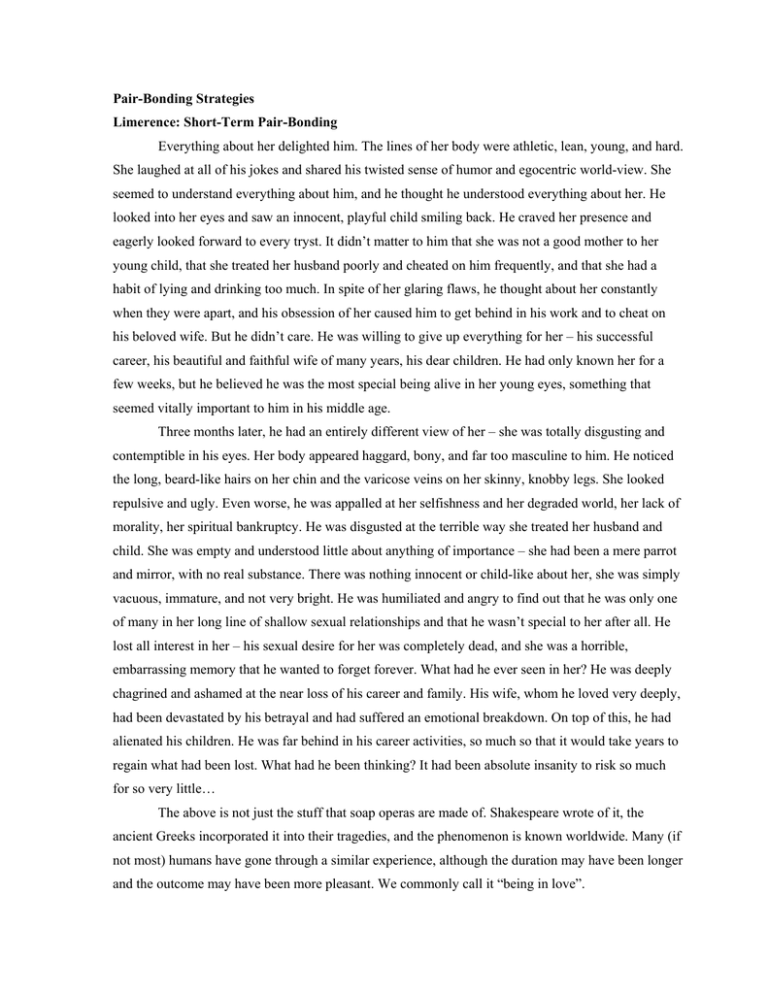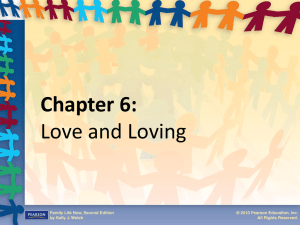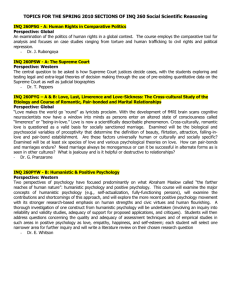
Pair-Bonding Strategies
Limerence: Short-Term Pair-Bonding
Everything about her delighted him. The lines of her body were athletic, lean, young, and hard.
She laughed at all of his jokes and shared his twisted sense of humor and egocentric world-view. She
seemed to understand everything about him, and he thought he understood everything about her. He
looked into her eyes and saw an innocent, playful child smiling back. He craved her presence and
eagerly looked forward to every tryst. It didn’t matter to him that she was not a good mother to her
young child, that she treated her husband poorly and cheated on him frequently, and that she had a
habit of lying and drinking too much. In spite of her glaring flaws, he thought about her constantly
when they were apart, and his obsession of her caused him to get behind in his work and to cheat on
his beloved wife. But he didn’t care. He was willing to give up everything for her – his successful
career, his beautiful and faithful wife of many years, his dear children. He had only known her for a
few weeks, but he believed he was the most special being alive in her young eyes, something that
seemed vitally important to him in his middle age.
Three months later, he had an entirely different view of her – she was totally disgusting and
contemptible in his eyes. Her body appeared haggard, bony, and far too masculine to him. He noticed
the long, beard-like hairs on her chin and the varicose veins on her skinny, knobby legs. She looked
repulsive and ugly. Even worse, he was appalled at her selfishness and her degraded world, her lack of
morality, her spiritual bankruptcy. He was disgusted at the terrible way she treated her husband and
child. She was empty and understood little about anything of importance – she had been a mere parrot
and mirror, with no real substance. There was nothing innocent or child-like about her, she was simply
vacuous, immature, and not very bright. He was humiliated and angry to find out that he was only one
of many in her long line of shallow sexual relationships and that he wasn’t special to her after all. He
lost all interest in her – his sexual desire for her was completely dead, and she was a horrible,
embarrassing memory that he wanted to forget forever. What had he ever seen in her? He was deeply
chagrined and ashamed at the near loss of his career and family. His wife, whom he loved very deeply,
had been devastated by his betrayal and had suffered an emotional breakdown. On top of this, he had
alienated his children. He was far behind in his career activities, so much so that it would take years to
regain what had been lost. What had he been thinking? It had been absolute insanity to risk so much
for so very little…
The above is not just the stuff that soap operas are made of. Shakespeare wrote of it, the
ancient Greeks incorporated it into their tragedies, and the phenomenon is known worldwide. Many (if
not most) humans have gone through a similar experience, although the duration may have been longer
and the outcome may have been more pleasant. We commonly call it “being in love”.
What does it mean to be “in love”? Like the song by Tina Turner, you might ask, “What’s love
got to do with it?”, for most of us are aware that being in love is not the same thing as loving someone.
Although we may develop deep or abiding love for someone with whom we are in love, being in love
is more akin to infatuation, obsession – and some would say madness – than it is to real love. As
Tennov writes: “It is not love. It is the force of evolution expressed as the compulsion for the
particular, this particular one above all others. Often, it is called love…” (Tennov, 1979; p. xii). But as
most of us know, it is not truly love.
Dorothy Tennov (1979), in her groundbreaking book, Love and Limerence, coined the word
“limerence” to describe the state of what is commonly known as being in love. She lists a number of
characteristics of limerence. Some of the more salient mental processes that the person who is limerent
(i.e., in love) is likely to experience include:
•
intrusive thinking about the limerent object (the LO, or the object of one’s desire)
•
acute longing for the LO to reciprocate affection
•
euphoria or buoyancy of mood when reciprocation occurs
•
feelings, thoughts, and actions focus on the LO to the extent that other concerns –
even very important ones – are ignored or neglected
•
a strong, delusional-like bias that distorts the limerent person’s perception of the LO:
this bias magnifies the appearance and importance of the LO’s admirable qualities
while simultaneously minimizing the LO’s negative traits, rendering them either
neutral or even positive
•
sexual desire for the LO
Being in love, limerence, is a physiological phenomenon that may have evolved to facilitate
pair-bonding for the purpose of conceiving children and nurturing them in the first few months or
years of life. The purpose of limerence appears to be to draw two people together into a bonded
relationship to order to ensure their mating – the conception and care of young. Tennov (1979) reports
that limerence, when reciprocated, seems to be most commonly directed, not just toward sexual
intercourse alone, but toward the creation of a love-nest in which to enjoy making love, producing and
raising offspring. Although limerence is more than simple sexual attraction, Tennov makes the point
that if sexual desire is lacking, then it isn’t true limerence.
If two individuals are limerent towards each other, the limerence can last for a long time.
However, in most cases, limerent feelings fade within a few months to a few years, rarely lasting more
than two or three years. The obsessiveness and euphoric episodes subside, and the LO’s negative traits
become more prominently noticeable, as shown in the real-life scenario described above. The
individuals may find that the previously minimized negative traits are too disturbing, and they will
break up – often with much arguing, bickering, and hatred. Even when limerance is reciprocated, it
usually doesn’t last longer than two to four years. A deeper, more abiding bond may develop between
the two individuals, and the relationship may continue to deepen through the years. But in these cases,
the limerance appears to be replaced by a different type of bond.
The most common time for divorce is in the fourth year after marriage, and this is congruent
with limerent theory (see Figure 5-6) (Fisher, 1992). Children by the age of two or three years are
walking, talking, feeding themselves, and have gained a modicum of independence. Two parents are
no longer as critical as they were earlier. Of course, two parents are usually better than one throughout
the life of the child. But from a bare-survival point of view, two parents are far more necessary to the
baby than to the older child. As a mechanism evolved to give an advantage to the young developing
child, limerence would not be expected to last more than the time needed to court, marry or form a
home together, conceive, bear a child, and perhaps nurture it until it is walking and possibly talking.
This would take approximately four years, and it is in the fourth year that most divorces occur,
presumably when limerence fades and a more enduring love doesn’t replace it.
Limerence is a strong force, and Tennov (1979) discusses its uncontrollable aspect. Her
massive amount of data, collected with interviews and surveys, suggests that limerence is preventable
primarily in two ways. First of all, if an individual has a psychological or cognitive barrier against
falling in love, he or she will be unlikely to fall prey to it. For example, if a married man has firmly
decided that he will be monogamous, he will be far less likely to fall in love with someone outside of
his marriage than would be someone who had not made such a conscious decision to be committed to
one person only. The second “window” of preventability occurs early on in the relationship. At this
point, if the individual begins to feel that special brand of “in love” attraction and doesn’t want it, he or
she can cut off all contact with the potential LO and nip the limerence in the bud.
The difficulty with which limerence is controlled or prevented attests to its hard-wired quality.
Being in love is akin to a drug-induced state and can even be addictive for some persons. Many
individuals who are sex addicts are actually limerence addicts – addicted to the euphoria of being in
love. These individuals fall in love with one person after another in a never-ending succession of
romantic affairs, each lasting a few months or years. These limerence addicts may be married to one
person for a number of years while having a series of affairs or romances outside of the marriage, or
they may have a long series of relationships, one after another, with none lasting more than a year or
two. Limerence addiction can be as pernicious as cocaine addiction and as damaging to the family unit
as alcoholism.
Tennov (1979) discusses three ways for limerent individuals to end their feelings of limerence.
They can stop all contact with the LO. In this way, the feelings will eventually subside and die out in
most normal people – although going “cold turkey” can be somewhat painful. The second way for
limerence to die is for the relationship to be consummated. Once the two individuals are spending time
together, the idealistic patina wears off and the couple either develops a more enduring love or they
break up. Thirdly, the limerence for one LO can be transferred to a different LO.
Long-term Pair-bonding
There may be a somewhat less intense and longer-term form of pair-bonding that is
qualitatively different from limerence. A long-term pair-bond is congruent with some of the
information gathered in Tennov's (1979) interviews with couples. Marriages that last for decades or
lifetimes are indicative of a long-term form of pair-bonding, whereas marriages that approximate a 4year span are indicative of a short-term form of pair-bonding.
The two forms of pair-bonding are thus differentiated:
(1) Limerence is the more intense, shorter-term pair-bond, congruent with those types of
people who tend to form short-lasting, relationships of either serial monogamy or polygamy, and
congruent with the 4th year divorce mode. Adolescents and young adults appear to be more likely to
form short-term pair-bonds than are mature and older adults. There may be a gender difference with
men tending to be somewhat more likely to form short-term bonds. Limerence is more akin to
infatuation, obsession, and delusion than it is to love. Limerence affords the opportunity for two
people to bond for the purpose of conceiving, giving birth, and perhaps raising a child up to the age of
walking and talking (approximately 1 to 2 years of age).
(2) A less intense, longer-term pair-bond also occurs, congruent with those types of people
who tend to form longer-lasting, monogamous relationships. More mature and older adults are more
likely to form long-term pair-bonds than are younger and more immature adults. This type of pairbond is more akin to abiding love than limerence is. It is not infatuational, obsessive, and delusional,
as limerence is. However, it does involve feelings of intense loyalty and affection, the tendency to see
the other in more positive than negative light, and strong possessiveness, protectiveness, and jealousy
of the other's affections. This longer-term type of bonding affords the opportunity to conceive, give
birth, and raise children until they are sexually mature or older (approximately age 13 – 15 years or
older). Both types of pair-bonding involve the desire to create a home or nest and engage in continual
sexual intercourse, and the tendency to give birth to young and nurture them.
There appears to be a developmental progression, with younger people more predisposed to
form short-term pair-bonding, and more mature adults more predisposed to form a long-term pairbond. The two strategies may also be preferred by different types of people. The type of person who
might opt for short-term pair-bonding might be more impulsive and more likely to have experienced a
tumultuous, unstable childhood, perhaps receiving low levels of nurturance. The type of person who
might opt for the long-term pair-bonding would have a less impulsive personality and would be more
likely to have experienced a calmer, more stable, more nurtured childhood. The two types of pairbonding may correspond with monogamous vs. polygamous strategies of mating, each conferring a
different type of evolutionary advantage.





